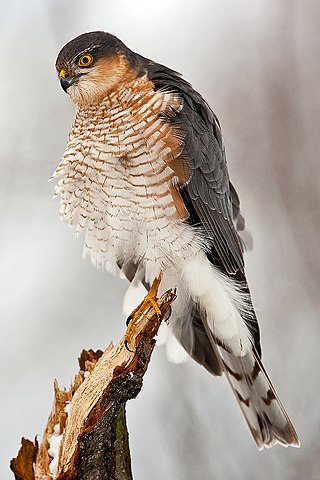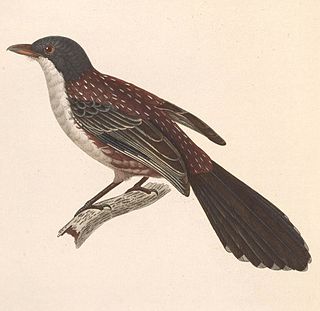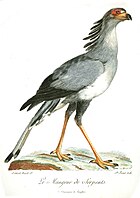
Accipiter is a genus of birds of prey in the family Accipitridae. Most species are called sparrowhawks, but there are many sparrowhawks in other genera too, such as Tachyspiza.

The Buteoninae are a subfamily of birds of prey which consists of medium to large, broad-winged species.

The shikra is a small bird of prey in the family Accipitridae found widely distributed in Asia and Africa where it is also called the little banded goshawk. The African forms may represent a separate species but have usually been considered as subspecies of the shikra. The shikra is very similar in appearance, as well as behavior, at least to some degree, to other species including the Chinese sparrowhawk, Eurasian goshawk and Eurasian sparrowhawk. They have a sharp two note call and have the typical flap and glide flight. Their calls are imitated by drongos and the common hawk-cuckoo resembles it in plumage. This species was formerly placed in the genus Accipiter.

The besra, also called the besra sparrowhawk, is a bird of prey in the family Accipitridae. It was formerly placed in the genus Accipiter. The name "besra" is from the Hindi word for the species.

The crested goshawk is a bird of prey in the family Accipitridae that is widely distributed in tropical Asia. It was formerly placed in the genus Accipiter.

The white-faced starling is a member of the starling family of birds. It is an endemic resident breeder in Sri Lanka.

The plumbeous kite is a bird of prey in the family Accipitridae that is resident in much of northern South America. It is migratory in the northern part of its range which extends north to Mexico. It feeds on insects which it catches either from a perch or while in flight.

The great black hawk is a bird of prey in the family Accipitridae, which also includes the eagles, hawks, and Old World vultures.

Aquila is the genus of true eagles. The genus name is Latin for "eagle", possibly derived from aquilus, "dark in colour". It is often united with the sea eagles, buteos, and other more heavyset Accipitridae, but more recently they appear to be less distinct from the slenderer accipitrine hawks than previously believed. Eagles are not a natural group but denote essentially any bird of prey large enough to hunt sizeable vertebrate prey.

The Indian spotted eagle is a large bird of prey native to South Asia. Like all typical eagles, it belongs to the family Accipitridae. The typical eagles are often united with the buteos, sea eagles and other more heavy-set Accipitridae, but more recently it appears as if they are less distinct from the more slender accipitrine hawks.

The grey goshawk is a strongly built, medium-sized bird of prey in the family Accipitridae that is found in eastern and northern Australia. The white morph of this species is known as the white goshawk. This species was formerly placed in the genus Accipiter.

The white-spectacled warbler is a species of leaf warbler in the family Phylloscopidae. It is found in Asia from the eastern Himalayas to south-eastern China and southern Vietnam. Its natural habitats are subtropical or tropical moist lowland forests and subtropical or tropical moist montane forests. It was formerly included in the Old World warbler family, Sylviidae.

The red-thighed sparrowhawk, alternatively known as the red-legged sparrowhawk or western little sparrowhawk, is a species of sparrowhawk in the family Accipitridae from western and northern central Africa. This species was formerly placed in the genus Accipiter.

The black-mantled goshawk is a species of bird of prey in the family Accipitridae. It is found in the highlands of New Guinea. Its natural habitat is subtropical or tropical moist lowland forests. This species was formerly placed in the genus Accipiter.

The little sparrowhawk is a species of Afrotropical bird of prey in the family Accipitridae. It was formerly placed in the genus Accipiter. It is the smallest member of the genus Tachyspiza and forms a superspecies with the red-thighed sparrowhawk.

The scissor-tailed kite, also known commonly as the African swallow-tailed kite and the fork-tailed kite, is a bird of prey in the family Accipitridae. It is the only species placed in the genus Chelictinia. It is widespread in the northern tropics of Africa.

The spotted crocias is a passerine bird in the family Leiothrichidae. It is endemic to the island of Java in Indonesia, where it is confined to west Java.

Van Hasselt's sunbird, is a species of bird in the family Nectariniidae. It is found in Northeast India, Bangladesh and Southeast Asia. Its natural habitats are subtropical or tropical moist lowland forests and subtropical or tropical mangrove forests.

Lophospiza is a genus of Asian birds of prey in the family Accipitridae. It is the only genus in the subfamily Lophospizinae. The two species placed in this genus were formerly placed in the genus Accipiter.

Aerospiza is a genus containing goshawks and a sparrowhawk in the family Accipitridae that are found in Africa. The three species in the genus were formerly placed in the genus Accipiter.




























